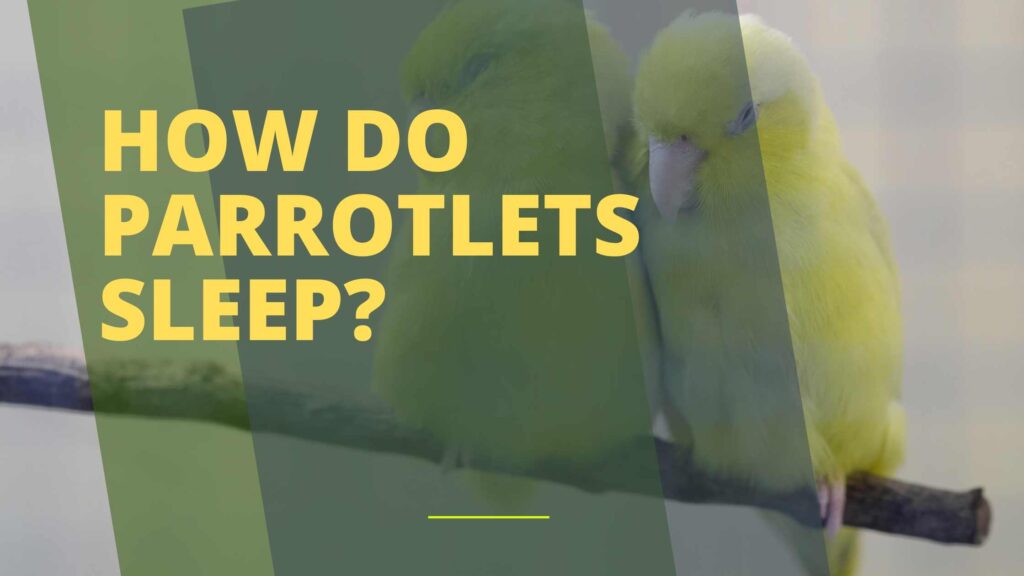Parrotlets typically sleep by perching on one foot, tucking their beak into their back feathers. They require a dark, calm environment and often sleep with their heads turned backward.
Table of Contents
Parrotlets, the pint-sized cousins of the mighty parrots, charm bird enthusiasts with their playful nature and compact size. These feathery friends are masters of rest, seeking out serene and secure spots to catch their nightly z’s. As dusk falls, you’ll find a parrotlet winding down from its day of exploration and social interaction.
How Do Parrotlets Sleep? Ensuring a consistent sleep routine is crucial for the well-being of these little birds. Owners are advised to provide a sleeping environment that mimics the tranquility of a wild evening roost, free from disturbances and excessive light pollution. Understanding and respecting the sleep habits of parrotlets is a vital aspect of their care. It promotes their health, happiness, and longevity, making every goodnight the prelude to a cheerful chirp at dawn.

The Sleep Habits Of Parrotlets
Parrotlets are tiny bundles of energy during the day, but come night-time, their sleep patterns are fascinating! Understanding how these miniature parrots rest can shed light on their overall health and happiness. Curious about how parrotlets sleep? Let’s dive into the nighttime world of these vibrant birds and uncover their sleep secrets.
Nature’s Sleepy Gems: Parrotlets
Just like humans, parrotlets need plenty of sleep to stay healthy. They mimic the sun’s cycle, preferring to snooze when it’s dark. Most parrotlets aim for about 10 to 12 hours of sleep a night. This is crucial for their well-being, as sleep affects their mood and immune system.
Nightly Rituals Of These Feathered Friends
Before bed, parrotlets often engage in rituals. They may fluff up their feathers, tuck their heads beneath a wing, or even cuddle with a mate if they have one. Creating a calm environment in their cage, with a consistent bedtime routine, helps them wind down.
- Dim the lights: Simulate sunset to signal bedtime.
- Quiet down: Keep noise to a minimum.
- Cover the cage: Use a light blanket to create a sense of security.
Ensuring your parrotlet has a comfortable sleep space is critical. A cozy cage with soft bedding helps them feel safe. Take care to avoid disturbances during their rest hours.
| Parrotlet Sleep Requirement | Duration |
|---|---|
| Night Sleep | 10-12 hours |
| Day Naps (optional) | Short and infrequent |
In essence, parrotlets treasure their sleep time. A happy bird will have a set sleep schedule that aligns with their natural instincts. Take special note of any changes; they could indicate a need for veterinary attention.
Understanding Parrotlet Sleep Patterns
Parrotlets, those tiny bundles of joy with vibrant feathers, need their beauty sleep just like us. Unlike humans, these little parrots have unique sleep habits that are fascinating to learn about. Knowing how your bird sleeps can help you create a comfortable and healthy environment for them. Let’s dive into the world of parrotlet slumber and understand their sleep patterns.
Circadian Rhythms In Birds
Birds, including parrotlets, follow a circadian rhythm—that’s their 24-hour internal clock that tells them when it’s time to sleep or be awake. This rhythm aligns closely with the light and dark cycles of the day. Keeping a consistent light schedule is key to maintaining a healthy sleep pattern for your parrotlet.
Phases Of Parrotlet Sleep
Parrotlet sleep has two main phases: REM (Rapid Eye Movement) and non-REM sleep. The REM phase is where parrotlets experience dreams, while non-REM sleep is a deep, restorative sleep. Usually, they sleep through the night but can have short naps during the day. Observe quiet hours to ensure your parrotlet gets uninterrupted night sleep.
Typical Nighttime Sleep Schedule
- Bedtime: Coincides with sundown
- Wake Time: With the sunrise
- Duration: 10-12 hours of nightly sleep
Daytime Napping Habits
- Brief, light naps
- Last for a few minutes
- Occur in a safe, comfortable spot
Creating a sleep-friendly environment involves covering the cage at night, reducing noise, and dimming the lights. Remember, a well-rested parrotlet is a happy and healthy companion.
Creating An Ideal Sleep Environment
Just like humans, parrotlets need a peaceful sleep environment to remain healthy and happy. Crafting the perfect sleep setting for these little birds is vital. Birds in the wild have evolved to sleep in secure and dark environments. Mimicking this in a parrotlet’s habitat ensures a restful night. Let’s explore how to create this ideal sleep space.
Comfortable And Secure Cages
A parrotlet’s cage is its sanctuary. It should be spacious and comfortable, yet secure for a stress-free sleep. The cage should provide enough room for the bird to move freely without feeling cramped.
- Bar spacing is crucial; too wide and your pet might escape, too narrow and it could harm their delicate feathers.
- Place soft perches for your bird to rest its feet at night.
- A high-quality lock will keep the cage closed, keeping your parrotlet safe from potential hazards.
- Position the cage in an area free from drafts and extreme temperature changes.
Importance Of Darkness And Quiet
Ensuring your parrotlet’s surroundings are dark and quiet at night is essential to its well-being. These birds require a consistent light schedule akin to their natural habitat.
- Use blackout curtains or a cage cover to block any intrusive light.
- Set the cage in a room used minimally at night to maintain tranquility.
- Consistent sleeping hours help. Aim for 10-12 hours of uninterrupted darkness.
- Minimize noise by turning off the TV and other electronics well before bedtime.
In short, a combination of a safe and comfortable habitat plus a serene atmosphere is key for a parrotlet’s restful slumber.
Credit: talkparrotlets.com
The Role Of Bedding And Perches
The Role of Bedding and Perches is integral to a parrotlet’s sleep. These small birds require a cozy environment. A good night’s rest boosts their energy. Quality sleep hinges on the proper setup within their cages.
Choosing The Right Materials
Comfort and safety dictate the choice of bedding and perches. Soft, non-toxic materials are important. They prevent foot injuries and respiratory issues.
- Use aspen or paper-based substrates: These are absorbent and dust-free.
- Avoid cedar or pine shavings: The aromatic oils can harm your bird’s health.
- Select natural wood perches: They mimic tree branches and promote foot health.
Placement For Optimal Sleep
Proper perch and bedding placement ensure a secure sleeping environment. Parrotlets prefer higher perches for rest. This aligns with their instinct to sleep up high, away from predators. A strategic cage layout contributes to tranquil sleep.
| Item | Placement | Reason |
|---|---|---|
| Bedding | Bottom of the cage | Keeps waste away from the bird |
| Sleeping perch | High in the cage | Offers a sense of security |
Ensure perches are away from food and water dishes to maintain cleanliness. Sleep areas should be clear of cage activity. This provides a quiet zone, free from disturbances.
Diet And Its Effects On Sleep
Did you know the diet of a parrotlet could affect how well it sleeps? Just like us, what these vibrant little birds eat influences their sleep quality. By understanding the link between nutrition and rest, you can ensure your feathered friend gets the best night’s sleep possible.
Nutritional Needs For Good Night’s Rest
For a parrotlet, diet is more than just fuel; it’s a foundation for healthy living. A balanced diet rich in essential nutrients sets the stage for restful sleep. Let’s dive into what to include for optimal nighttime snoozing:
- Vitamins and minerals support the nervous system.
- Complex carbohydrates found in grains provide sustained energy.
- Proteins help repair the body and regulate sleep cycles.
- Fats in moderation are important too, but the right kinds matter.
Foods That Can Disrupt Sleep
Just as some foods can set your parrotlet up for a peaceful night, others can spell trouble for its rest. Be cautious with:
| Food Type | Reason for Disruption |
|---|---|
| Sugary Treats | Can cause energy spikes and crashes, upsetting sleep. |
| Caffeine | Found in chocolate, can keep your bird awake and restless. |
| Fatty Foods | Hard to digest, leading to discomfort at bedtime. |
Remember, feeding your parrotlet late in the evening can also lead to disturbed sleep. Aim for a dinner time that allows for digestion before the lights go out, ensuring your bird can rest uninterrupted.

Credit: www.pinterest.co.uk
Common Sleep Disturbances In Parrotlets
Little parrotlets need peaceful sleep to stay happy and healthy. Like us, they can have sleep trouble. Bright lights, loud noises, or even a change in their environment might upset their sleep. Let’s look at what disturbs their rest and how to spot sleep issues.
Recognizing Sleep Disorders
Parrotlets can show signs when their sleep isn’t right. Watch for these:
- Daytime sleep: Napping more than usual.
- Nighttime restlessness: Tossing in their cage at night.
- Feather troubles: Plucking or damaging their own feathers.
- Changes in behavior: Being grumpy or not wanting to play.
Impact Of Stress And Anxiety
Stress can mess with a parrotlet’s sleep. Things that stress them out include:
| Cause | Sign |
|---|---|
| New pets or people | They may seem scared or hide. |
| Loud sounds | Sudden noises can make them jumpy. |
| Changes in home | Moving their cage might unsettle them. |
Keep a cozy, calm space for your parrotlet. This helps them relax and sleep tight!
Routine: The Key To A Restful Slumber
Parrotlets, like humans, thrive on routine for sound sleep. A regular schedule calms them and sets their internal clocks. Knowing when to expect bedtime helps these tiny birds unwind and fall into a deep, restful slumber.
Establishing A Sleep Schedule
Creating a fixed bedtime routine is vital for parrotlets. These birds need 10-12 hours of sleep each night. Align their schedule with sunrise and sunset when possible. This mimics their natural environment, promoting healthier sleep patterns.
- Choose a bedtime that works with your schedule and stick to it.
- Dim the lights an hour before to signal that it’s winding-down time.
- Quiet the environment to help your parrotlet relax.
Consistency In Nightly Practices
Consistency is crucial for reinforcing sleep cues. Daily repetition of specific actions before bedtime helps your bird recognize it’s time to rest.
- Same perch: Always place your parrotlet on its favorite sleep perch.
- Soft sounds: If you use background music, play the same soft tunes nightly.
- Light cover: If you cover the cage, use a light, breathable fabric.
Keeping these practices constant will ensure your parrotlet knows when it’s time to sleep and wakes up refreshed.
Monitoring Your Parrotlet’s Sleep
Understanding how your parrotlet sleeps can ensure they stay healthy and happy. To keep an eye on your little friend’s sleep, look for regular patterns. Such patterns are crucial for their overall well-being. Let’s explore what a healthy slumber looks like for these colorful birds and when a trip to the vet might be necessary.
Signs Of Healthy Sleeping Patterns
- Consistency: Sticking to a sleep schedule.
- Quietness: Minimal noise during rest.
- Comfort: Choosing a cozy spot in the cage.
- Relaxation: Calm and unflustered sleep posture.
Birds like parrotlets need darkness and quiet to sleep well. Make sure their cage is in a tranquil environment as night falls. They usually rest for about 10 to 12 hours each night. Cover their cage with a breathable cloth to create a night-time ambience.
When To Consult A Veterinarian
If you notice any odd sleeping behaviors, it may be time for professional advice. Here are key signs that your parrotlet might need a vet’s attention:
| Sign | Description | Action |
|---|---|---|
| Sudden Changes: | Shifts in sleeping patterns or spots. | Observe and consult. |
| Restlessness: | Continuous shifting or waking up. | Seek expert opinion. |
| Excessive Sleep: | Sleeping more than usual. | Monitor and report. |
| Vocalizations: | Crying or screaming during sleep. | Check and address concerns. |
It’s crucial to remain vigilant to your parrotlet’s sleep habits. Overnight changes or distress signs could indicate health issues. Early detection leads to swift treatment and a happier parrotlet. Remember, your goal is to maintain a serene, consistent sleep environment to encourage good health for your feathered companion.
Conclusion
Understanding parrotlet sleeping patterns is crucial for their well-being. These tiny birds require tailored environments to ensure a restful slumber. Ensuring a dark, quiet space can greatly enhance their sleep quality. Remember, a well-rested parrotlet is a happy, healthy companion.
Provide them with the care they need for a peaceful night’s rest.
Ryan Everhart is a passionate bird enthusiast and blogger, primarily writing on his website, Avian Whispers. His journey into the world of bird blogging began with a deep interest in parrots, a species that captivated his attention for their intelligence and social behavior. Over time, his content expanded to cover a broader range of bird species, offering insights into bird behavior, care, habitats, and conservation.
Ryan is dedicated to educating his audience, which includes both new bird owners and seasoned enthusiasts. His writing is filled with personal experiences, expert knowledge, and practical advice on bird care. Through Avian Whispers, he aims to foster a deeper appreciation for birds, emphasizing their role in nature and the joys of having them as pets.
Starting with articles focused on parrots, Ryan’s work now encompasses a diverse range of topics such as feeding, training, habitat enrichment, and bird health. His love for birds extends beyond parrots, diving into various avian species. His informative and heartfelt writing reflects his commitment to the well-being of birds and the desire to help others connect with these creatures.
As a growing voice in the bird blogging community, Ryan strives to provide a platform where bird lovers can learn, share experiences, and connect over a shared passion for avian life. His blogs are not only educational but also serve as a reminder of the importance of protecting and nurturing the bond between humans and birds.




